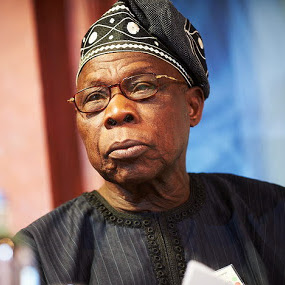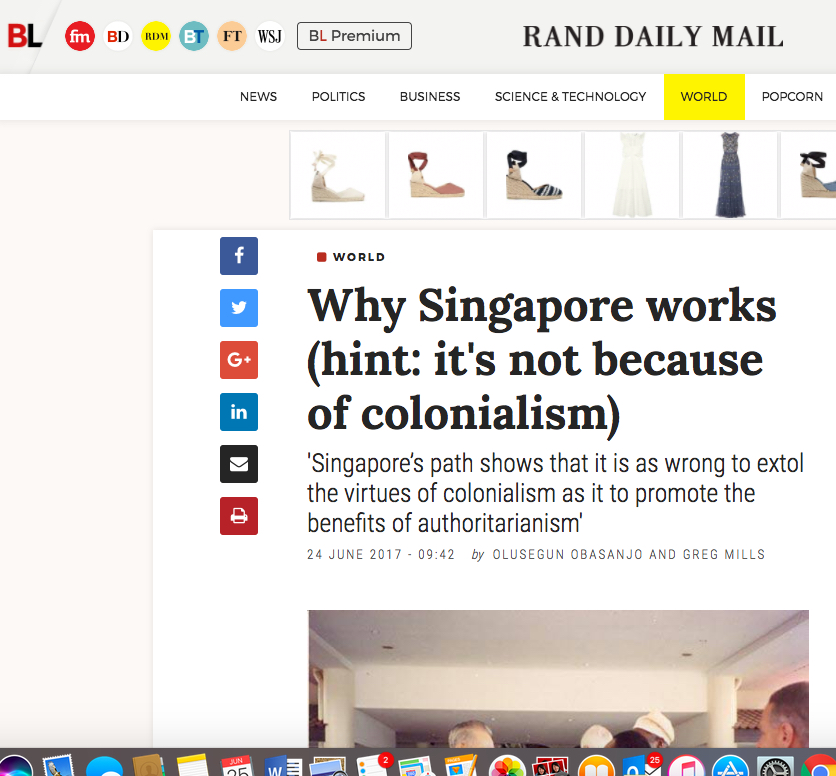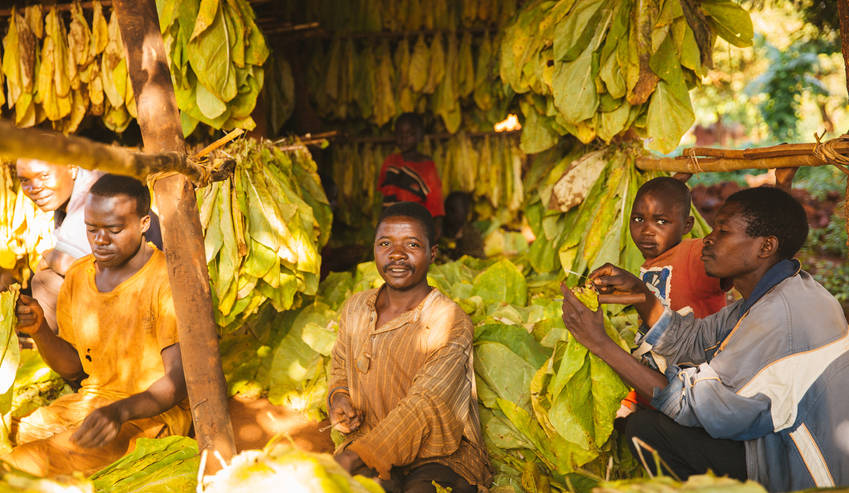News
Why Singapore works (hint: it's not because of colonialism)
Singapore offers an excellent learning opportunity to understand Africa's growth puzzle from an East Asian perspective.

Former President of Nigeria; Chairman and Advisory Board Member Emeritus, The Brenthurst Foundation

Director, The Brenthurst Foundation

Amidst the Twitter storm of ‘what did the colonialists ever do for us’ is lost the message and mechanics of Singapore’s economic development. Often the wrong lessons – of a belief in the value of a benign dictator – are taken by those seeking single issue answers. Singapore’s path shows that it is as wrong to extol the virtues of colonialism as it to promote the benefits of authoritarianism.
When Lee Kuan Yew started as the leader of independent Singapore in 1965, the island was a fragile, poor backwater. Born amidst crisis arising from the separation of the Malay Federation and Konfrontasi with Indonesia, the city-state was riven with racial, ethnic and religious fault lines. Its infrastructure was geared to colonial purpose, including the dockyards. Two-thirds of its then 1.6 million people lived in overcrowded slums, most without water-borne sewerage, and many without employment, on a tiny island-state of just 580-km2.
Fifty years later, Singapore’s GDP per capita stood at US$52,887 – over 50 times more than at independence and nearly 20 percent greater than that of the United Kingdom, the former colonial power.
Over the same period, per capita incomes in sub-Saharan Africa have increased just US$200 to average US$1,000.
Yet back in 1968, it was Singapore looking to Africa for lessons on growing its economy. That year, recalled Kenya’s former Prime Minister, Raila Odinga, ‘a team of Singaporeans came to Kenya to learn our lessons, since we were then a more developed country than they were.’
Forty years later, Odinga reflects, ‘I took a study trip to Singapore with six ministers. That was the latest in many trips taken by the Kenyan government, about which no report was ever written, and where the participants kept everything to themselves. I said that this trip had to be different, that we had to translate our findings into actions. On our return, I asked for a plan of action from each minister learning from Singapore, since there was no point in reinventing the wheel. Each minister was tasked to prepare their action plan against our Vision 2030 …. But after I left government [in 2013],’ he depressingly observed in 2016, ‘nothing further happened.’
East Asia seemed to have few advantages over Africa at the point of decolonisation. Ethnic disunity, frail institutions and limited governance outside of the capital was common. Weak democracy, subsistence agriculture, fragmentary external trade linkages and acute social stratification were also typical. Both regions shared a history of commodity and colonial exploitation, where the conquerors were sharply divided from the conquered by race, though there was a tendency on the part of the colonial rulers to favour some local groups over others. In both ‘settlers’ were imposed on the local populations, arousing particularly intense hostility. This left them not only with unnatural borders and poor terms of trade, but their people with a devalued sense of their own worth, angry with outsiders yet lacking confidence in their own abilities and suspicious of their fellow citizens.
The colonialists – be they British, French, Portuguese or Belgian – established highly interventionist states that actively prevented indigenous economic enrichment, while protecting white settlers, colonial companies and monopoly capital.
By and large, the African leaders that emerged after independence were comfortable with the economic systems they inherited (once stripped of racism), especially as state intervention offered many patronage opportunities. This pattern was exaggerated by the failure of most liberators to have a plan beyond redistribution to their preferred constituents.
Singapore offers an excellent learning opportunity to understand Africa’s growth puzzle from an East Asian perspective. However, often the wrong lessons are taken. For some Africans, East Asia’s development success has been used to justify authoritarianism, given that the region’s economies have managed high economic growth rates without full political rights. The need for a ‘strong man’ in Africa is the parlance in this regard, forgetting the historical record of such strongmen, when political power has seldom if ever been used for the benefit of development. There are good reasons why African electorates have preferred democracies over the alternative of a ‘benign dictatorship’, not least since this style of government is oxymoronic.
While Singapore, like others in the region – including South Korea, China, Indonesia and Taiwan – has modernised under a system of rigid political control, the image of Lee Kuan Yew as the ‘Big Man’ lacks sufficient nuance. Singapore’s economic development involved much more than one person and fundamentally relied on the establishment of robust institutions with strong and honest leadership and commitment. Although Lee presented the articulate public face and adroitly managed the politics and personalities, his was a formidable team. Lee’s memoirs are testament to how highly he regarded the opinion of his colleagues and how often there were differences of outlook within government on key issues.
There are many other aspects of Singapore’s economic success which have been similarly overlooked by advocates for autocracies. These include high spending on education, bureaucratic responsiveness, attractive policy for business investment, low wage industries, high productivity, investment in infrastructure, raised agriculture outputs as an initial spur to growth, and an overwhelming focus on competitiveness.
It was not inevitable that Singapore would be rich. Independence was a tough time, reflected S.R. Nathan, the sixth president of Singapore, who served nearly a dozen years before retiring from his post in 2011. ‘We had our backs to the wall.’ Nathan noted in an interview in 2014. ‘We had no money, no skills and no resources. But we had a group of leaders with a common purpose and a common vision.’
While recognising historical differences, both between East Asia and between African countries themselves, what lessons might Africans usefully take from Singapore? Eleven stand out:
1. Know the purpose of government:
One of the prominent features of Lee’s time in office was the vision he had for Singapore and his ability to allow others, notably the private sector, to help bring it to reality. He understood that the role of government was in creating the conditions that enable growth – as opposed to being the main driver for growth – and took development decisions towards that end by investing in education, housing, infrastructure and policies that made it easier to do business in Singapore.
2. Change the pattern of the colonial economy:
Lee quickly realised that, with Singapore’s ‘limited options’ to survive the country had to ‘make extraordinary efforts’ and in the process ‘render obsolete our role as the entrepôt and middleman for the trade of the region. We had,’ he concluded, ‘to be different’ in order to address high unemployment and social tension. This change saw Singapore, first, move into low cost manufacturing, then convert the British military facilities which unexpectedly closed in 1971, to civilian use, and all the while attract multinational companies to the island. Its strategy required continuous improvement and reinvention: from manufacturing through services and a digital transition, to its contemporary green economic phase. This did not mean ignoring the country’s colonial past but rather using the resources available at the time to move Singapore to a future that was not defined by the structures put in place by its colonial masters.
3. Build institutions:
While the state under Lee was undoubtedly at the helm of this transformation, additional lessons include the guiding of all actions by commercial principles, balance of power through devolution and shared responsibility among fellow ‘founding fathers’. Contrary to the notion of one person running things from the centre, the reality of Lee’s rule was quite different. His government, and those of his successors, involved top-quality peers, not just one ‘big man’. Singapore has been reliant on institutions in the pursuit of development, a mindset and practice cultivated by Lee.
4. Integrate don’t isolate:
Singapore’s transformation has been underpinned by a drive to globalise rather than nationalise. Whereas African countries routinely make it difficult to move goods in and out, Singapore has capitalised on its strategic geographic crossroads by matching policies and the focus of institutions. There is a zero tariff on imported goods, low tax rates (personal and corporate tax rates are capped at 20 per cent and 18 per cent respectively), a range of free trade agreements, vigorous trade and export promotion, and nearly 40,000 international corporations on the island. In this way, Singapore has acted to strengthen regulatory institutions to negate any perception of developing country risk.
5. Attract talent:
Singapore made sure that the best and brightest were in government, that they were paid properly, and they were given full support by leadership to do their job. As Lee observed ‘equal opportunities for all and meritocracy, with the best man or woman for the job, especially in leaders in government’, were basic principles that have helped us progress’. Moreover ‘legitimacy through performance’ was central to gaining and maintaining the confidence that the island’s citizens had in its impressive leaders. In proving the adage that ‘any country with a skills problem has an immigration problem’, the importation of talent has also been a key aspect to Singapore’s success. From little over one million people at independence, Singapore’s current population stands at 5.5 million, including around 1.5 million expatriates, permanent residents and migrant workers. The injection of immigrants is part of a strategy to maintain GDP targets, and synchs with the need continuous innovation and the search for a competitive advantage.

6. Invest in the infrastructure that makes growth possible:
Singapore’s focus on being a welcome environment for international investment meant creating the logistical and infrastructural framework to support that investment. An endeavour is clearly seen in the Port of Singapore. More than 32 million containers are offloaded at the port yearly, the world’s second-busiest. The customs clearance time is officially under ten minutes, though in practice this is as quick as a mouse-click for 99.9 percent of imports. A considerable achievement when compared to minimum clearance times of 72 hours in Mombasa. Singapore’s efficiency has been achieved through technology and the implementation of seemingly straightforward procedures such as, profiling customers and goods, and imposing strict penalties for transgressors.
7. Government should catalyse, not capture:
African governments like to cite Singapore as an example in the maintenance of their own parastatals and ‘partystatals’ (companies owned and/or run by ruling parties), both routinely notorious in crowding out private sector competition to the advantage of narrow financial and patronage interests. Again, such lessons are wide of the mark. An example of how to do this differently is in Temasek Holdings, a government-owned US$180-billion Singapore investment company. Despite its statist origins, Temasek’s strategy and role is based on commercial rather than political rationale. This avoids the intellectual suffocation and bureaucratic inertia of nationalised entities and creates a powerful investment vehicle for Singapore.
8. Manage labour relations:
Labour relations in Singapore have been driven by the maxim ‘it is better to have a low-paying job than no job at all’ balanced by a set of laws that spelled out minimum employment conditions, placing limits on retrenchment benefits and overtime benefits. This created a co-operative environment between government, the unions and business. Lee realised early on that union practices were ‘forcing employers to become capital-intensive, investing in expensive machines to get the work done with the minimum of workers [creating] a small group of privileged unionised workers getting high pay and a growing band of underpaid and underemployed workers. He thus made it illegal for a union to take strike or industrial action without a secret ballot, continuously stressing the importance of wider employment over narrow privilege and was able to decrease strikes from 153 between 1961-1962 to zero by 1969.
9. Deal with the finer details, and make tough decisions:
From the slums of the 1960s, by 2015, 83 percent of Singapore’s 5.5-m population lived in publically-supplied HDB apartments, 90 percent own their own homes, the rivers are clean, the island is 15 percent larger as a result of land reclamation, and despite the population increase, green cover has increased to 47 percent of the territory. Singapore’s mandatory Central Provident Fund savings scheme, promoted by Lee, enabled the construction of housing and home ownership on a grand scale, also seemingly offers a way around the chronically low savings rate across Africa. While the same land scarcity challenge does not face Africa per se, it is relevant to the increasing crush in African cities. Success has depended, not on a few big or iconic infrastructure projects or even the provision of necessary funding, housing and land, but fundamentally on setting clear targets and making the difficult decisions that would allow them to become a reality.
10. Use international relations to your advantage:
Lee used his international engagements, including a sabbatical at Harvard in 1968, to understand better the ebbs and flows of world politics and economics and, importantly, to win investors over. The Singaporeans set up the Economic Development Board (EDB) in 1961 specifically to provide a one-stop shop for investors and promote investment through its overseas offices. But Lee backed this up with personal commitment. Every time he visited the United States he would arrange to meet between 20-50 executives, to enable those CEOs who ‘had not time to visit Singapore … to see and assess the man in charge before they set up a factory there.’ He was able to gauge how these investor minds worked. ‘They looked,’ Lee wrote, ‘for political, economic and financial stability and sound labour relations to make sure that there would be no disruption in production that supplied their customers and subsidiaries around the world.’
11. Use aid, don’t rely on it:
Despite the fad to bash aid as the explanation for all of Africa’s problems, Asian countries have received comparatively large amounts of donor assistance. During the 1960s, aid per capita received by both regions was similar. Whereas some Asian countries enjoyed especially large aid flows (South Korea and Taiwan), and continue to do so (Vietnam), aid has not been relied upon as the single source of income. Asian countries have put aid to good use, with improved governance, sound polices, effective planning and clearer, firmer local ownership of projects. Lee was, however, adamant that his government should nurture a ‘spirit of self-reliance’, avoiding an ‘aid dependent mentality. If we were to succeed,’ he stated, ‘we had to depend on ourselves.’ Or as he put it to Singaporean workers: ‘The world does not owe us a living. We cannot live by the begging bowl.’
When I (Olusegun Obasanjo) asked Prime Minister Lee what the secret of his success was, he responded that there was no miracle, but that rather ‘We did a few things right and well, and continued to do them right and well, widening and deepening them all the time’. Singapore’s extraordinary transition has hinged on the government’s credibility among its population and the trust emanating from that, which has forged both a sense of common identity and unity of purpose. And that, in turn, has depended on its record of delivery rather than playing politics with the past.
President Obasanjo and Dr Mills are co-authors of the recently-released ‘Making Africa Work: A Handbook for Economic Success’ (Tafelberg/Hurst/OUP).
This article was originally published in the Rand Daily Mail.

